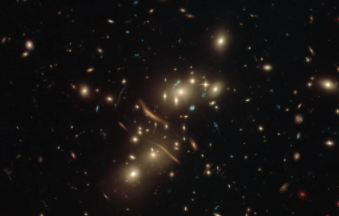The galaxy cluster Abell 2813 (also known as ACO 2813) has an almost fragile elegance in this picture from the NASA/ESA Hubble Space Telescope, which also highlights the impressive mechanics at work within it. The picture exemplifies gravitational lensing in a stunning way.
📷 This image from the NASA/ESA @HUBBLE_space Telescope shows the galaxy cluster Abell 2813, and spectacularly demonstrates the concept of gravitational lensing 👉 https://t.co/F5BypzkLMR pic.twitter.com/0YpGiagmgu
— European Space Agency (@esa) April 12, 2021
There are many distinct crescent shapes in the tiny dots, spirals, and ovals that make up the cluster's galaxies. There aren't curved galaxies but curved light arcs. They are excellent examples of gravitational lensing, a process that occurs as light bends through an object.
When the gravity of an object forces light to bend, this is known as gravitational lensing. Light from galaxies outside Abell 2813 is visible as curved crescents and "S" shapes. The galaxy cluster serves as a gravitational mirror because of its mass, bending light from more distant galaxies surrounding it. These distortions can take on a variety of forms, as long lines or arcs.
This visual proof of Einstein's theory of general relativity that mass allows light to bend is well-known.
Hubble Space Telescope

In 1990, the Hubble Space Telescope was deployed into space aboard the space shuttle Discovery's payload bay. The key goal was to determine the Universe's distance scale (how deep it is) and the origins of the elements found in space. That is what scientists are interested in. But the photos it produces! That is what fascinates the majority of mankind.
Abell 2813 (ACO 2813)

Thousands of galaxies of various ages, colors, and sizes make up galaxy clusters.
They have a mass that is about one million billion times that of the Sun.
Galaxy clusters were once thought to be the largest structures in the Universe before superclusters, which usually contain thousands of galaxy clusters and classes and range hundreds of millions of light-years, were discovered in the 1980s.
On the other hand, clusters have one advantage: superclusters are not tied together by gravity, but galaxy clusters continue to hold the status as the Universe's largest gravity-bound objects.
Read also: Potential Faster-Than-Light-Space Travel Facts: Alcubierre's Warp, the Key To Interstellar Travels?
Deep Space Exploration

Extreme space exploration (also known as deep-space exploration) is a field of astronomy, astronautics, and space science concerned with reaching the far reaches of space.
However, there is no agreement about what "distant" regions represent. It may also be used to refer to outer space in some cases. According to the International Telecommunication Union, deep space begins at a depth of 2 million kilometers (roughly 0.01 AU) from the Earth's atmosphere. NASA's Deep Space Network has used standards ranging from 16,000 to 32,000 kilometers from Earth. Human spaceflights (deep-space astronautics) and robotic spacecraft also perform physical space exploration.
For more Space news, don't forget to follow Nature World News!
© 2025 NatureWorldNews.com All rights reserved. Do not reproduce without permission.





